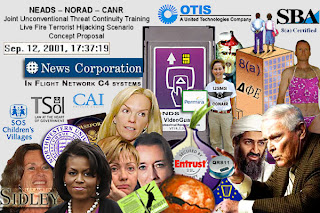 Abel Danger memo to file:
Abel Danger memo to file: Extorted Greek-Life Cannibal Oath Takers - Led by the Late Gen. Alexander Haig? - Synchronizing Otis 8(a) Elevator Bombing Attacks - NYC’s WTC On 9/11
We need to brush up on "The Art of War"
Ballistics 9/11 was a 'triphibious' attack on the United States and required the late General Alexander Haig's experience at the strategic command level of NATO to covertly synchronize the different SWAT teams as they executed ...
A land attack on WTC#7
An air attack on the Twin Towers
A naval attack on the Pentagon's U.S. Navy Command Center.
It appears that Rockwell Collins directors suspected that something by way of a snuff-film script was coming down the In-Flight Network wire and they desperately tried to disassociate themselves from Kristine Marcy's 8(a) protege companies and the propagandists at Murdoch's News Corp.
1. Laying Plans/The Calculations explores the five fundamental factors (the Way, seasons, terrain, leadership, and management) and seven elements that determine the outcomes of military engagements. By thinking, assessing and comparing these points, a commander can calculate his chances of victory. Habitual deviation from these calculations will ensure failure via improper action. The text stresses that war is a very grave matter for the state, and must not be commenced without due consideration.
2. Waging War/The Challenge explains how to understand the economy of warfare, and how success requires winning decisive engagements quickly. This section advises that successful military campaigns require limiting the cost of competition and conflict.
3. Attack by Stratagem/The Plan of Attack defines the source of strength as unity, not size, and discusses the five factors that are needed to succeed in any war. In order of importance, these critical factors are: Attack, Strategy, Alliances, Army, and Cities.
4. Tactical Dispositions/Positioning explains the importance of defending existing positions until a commander is capable of advancing from those positions in safety. It teaches commanders the importance of recognizing strategic opportunities, and teaches not to create opportunities for the enemy.
5. Energy/Directing explains the use of creativity and timing in building an army's momentum.
6. Weak Points & Strong/Illusion and Reality explains how an army's opportunities come from the openings in the environment caused by the relative weakness of the enemy in a given area.
7. Maneuvering/Engaging The Force explains the dangers of direct conflict and how to win those confrontations when they are forced upon the commander.
8. Variation in Tactics/The Nine Variations focuses on the need for flexibility in an army's responses. It explains how to respond to shifting circumstances successfully.
9. The Army on the March/Moving The Force describes the different situations in which an army finds itself as it moves through new enemy territories, and how to respond to these situations. Much of this section focuses on evaluating the intentions of others.
10. Terrain/Situational Positioning looks at the three general areas of resistance (distance, dangers, and barriers) and the six types of ground positions that arise from them. Each of these six field positions offer certain advantages and disadvantages.
11. The Nine Situations/Nine Terrains describes the nine common situations (or stages) in a campaign, from scattering to deadly, and the specific focus that a commander will need in order to successfully navigate them.
12. The Attack by Fire/Fiery Attack explains the general use of weapons and the specific use of the environment as a weapon. This section examines the five targets for attack, the five types of environmental attack, and the appropriate responses to such attacks.
13. The Use of Spies/The Use of Intelligence focuses on the importance of developing good information sources, and specifies the five types of intelligence sources and how to best manage each of them.
No comments:
Post a Comment
Note: Only a member of this blog may post a comment.